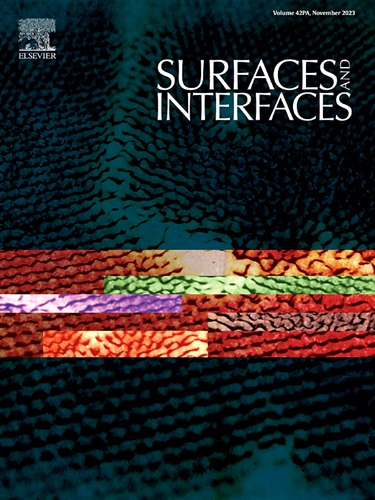以MIL-101为模板构建的中空z异质结纳米催化剂MIL101(Fe)@CdIn2S4用于高效光催化降解四环素
IF 6.3
2区 材料科学
Q2 CHEMISTRY, PHYSICAL
引用次数: 0
摘要
由于空心结构具有减轻重量、缩短电荷传输距离、提高比表面积、增强光吸收能力和提高载流子分离效率等优点,因此在光催化剂的制备和有机废物的减少中得到了广泛的应用。然而,与模板选择和删除有关的复杂程序对其广泛实施构成了相当大的障碍。为此,以MIL-101(Fe)为模板,采用简单的两步水热法合成了高效降解四环素(TC)的八面体中空MIL-101(Fe)@CdIn2S4 (HMC)光催化剂。HMC光催化剂保持了MIL-101(Fe)固有的八面体形态。与CdIn2S4 (CIS)的嵌段形态相比,HMC独特的中空结构不仅使TC分子更容易积聚,而且提高了对可见光的吸收。此外,MIL-101(Fe)与CIS之间形成的z型异质结促进了光生载流子的分离,从而提高了光催化性能。光催化活性评价表明,15mg HMC在140 min内对TC的降解率达到97%,降解速率常数分别是MIL-101(Fe)和CIS的9.1倍和3.2倍。这与以往的研究相比,使用更少的催化剂和更短的反应时间,具有更高的光催化降解效率。研究了不同参数下HMC的合成条件,并对MIL-101(Fe)的动态CIS蚀刻和原位生长进行了研究。形态学和微观结构分析证实了n型CIS催化剂纳米颗粒在MIL-101(Fe)晶体外部有序而密集地组装。采用电子自旋共振(ESR)、液相色谱-质谱(LC-MS)、毒性试验和密度泛函理论(DFT)分析对TC的降解过程进行了深入的研究。本文章由计算机程序翻译,如有差异,请以英文原文为准。

Well-constructed of hollow Z-heterojunction nanocatalysts MIL101(Fe)@CdIn2S4 using MIL-101 as a template for efficient photocatalytic degradation of tetracycline
Hollow structures are employed extensively in the preparation of photocatalysts and the reduction of organic waste as a consequence of their advantageous characteristics, including reduced weight, shorter charge transport distances, higher specific surface areas, boosted photoabsorption capabilities and improved separation efficiency of charge carriers. Nevertheless, the intricate procedures associated with template selection and removal present considerable obstacles to their extensive implementation. Hereby, a simple two-step hydrothermal process was employed to synthesize octahedral hollow MIL-101(Fe)@CdIn2S4 (HMC) photocatalysts for efficient tetracycline (TC) degradation, with using MIL-101(Fe) as a template. The HMC photocatalyst maintains the intrinsic octahedral morphology of MIL-101(Fe). In comparison to the block morphology of CdIn2S4 (CIS), the unique hollow structure of HMC not only makes it easier for TC molecules to accumulate but also improves the absorption of visible light. Furthermore, the Z-type heterojunction formed between MIL-101(Fe) and CIS facilitates the secession of photogenerated charge carriers, thereby enhancing photocatalytic performance. Photocatalytic activity assessments demonstrate that 15 mg of HMC achieves a remarkable TC degradation rate of 97 % within 140 mins, and the degradation rate constants are 9.1 and 3.2 times greater, than those of MIL-101(Fe) and CIS. This represents a superior photocatalytic degradation efficiency when compared to previous studies, with the use of a smaller quantity of catalyst and a shorter reaction time. Moreover, this research investigates the synthesis conditions of HMC under various parameters and elucidates the dynamic CIS etching and in-situ growth on MIL-101(Fe). Morphological and microstructural analyses confirm the orderly and dense assembly of n-type CIS catalyst nanoparticles at the exterior of the MIL-101(Fe) crystal. A comprehensive investigation employing electron spin resonance (ESR), liquid chromatography-mass spectrometry (LC-MS), toxicity assays, and density functional theory (DFT) analyses was conducted to give a deeper understanding into the TC degradation process.
求助全文
通过发布文献求助,成功后即可免费获取论文全文。
去求助
来源期刊

Surfaces and Interfaces
Chemistry-General Chemistry
CiteScore
8.50
自引率
6.50%
发文量
753
审稿时长
35 days
期刊介绍:
The aim of the journal is to provide a respectful outlet for ''sound science'' papers in all research areas on surfaces and interfaces. We define sound science papers as papers that describe new and well-executed research, but that do not necessarily provide brand new insights or are merely a description of research results.
Surfaces and Interfaces publishes research papers in all fields of surface science which may not always find the right home on first submission to our Elsevier sister journals (Applied Surface, Surface and Coatings Technology, Thin Solid Films)
 求助内容:
求助内容: 应助结果提醒方式:
应助结果提醒方式:


